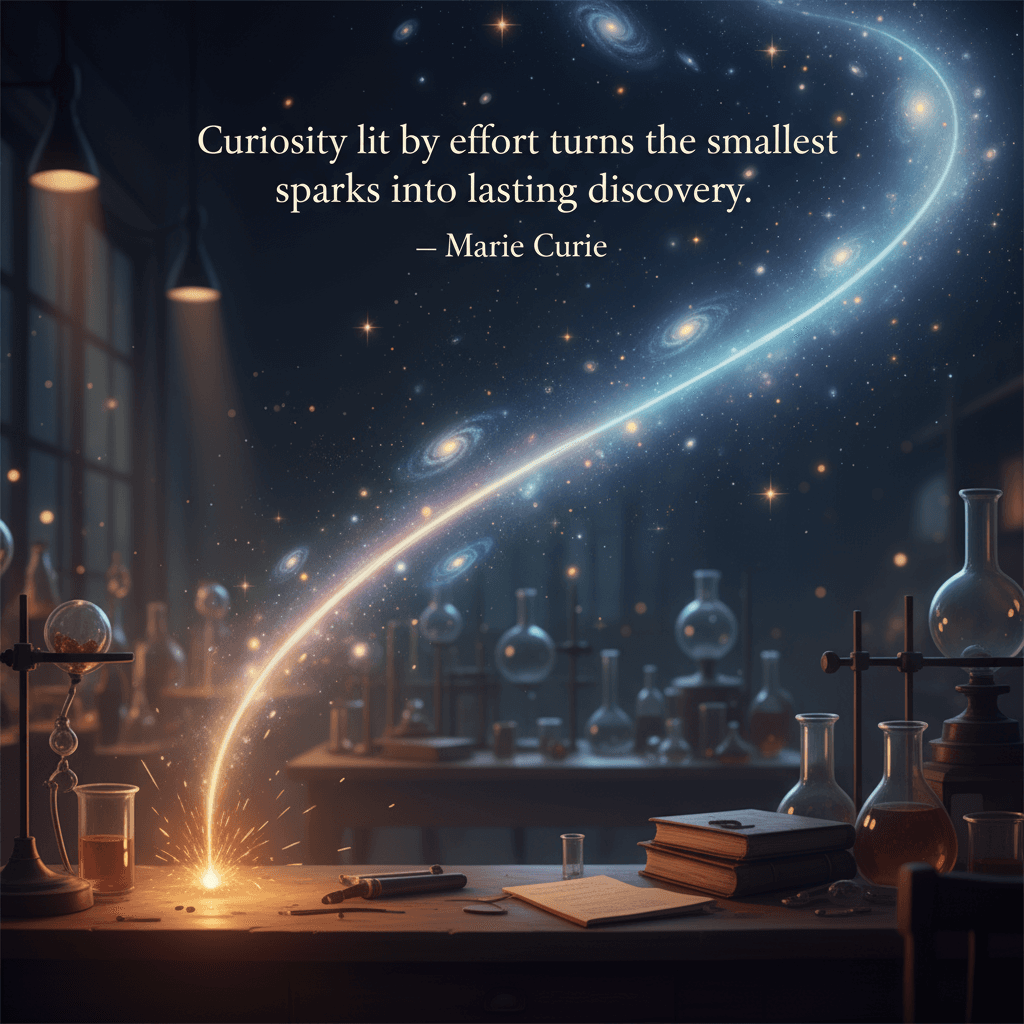Curiosity Fueled by Effort Yields Enduring Discovery

Curiosity lit by effort turns the smallest sparks into lasting discovery. — Marie Curie
From Spark to Sustained Flame
Curie’s line captures a simple engine of progress: curiosity ignites, but effort keeps the fire. A question alone flickers; repeated trials, careful notes, and patient refinement transform wonder into knowledge that lasts. This pairing reframes discovery not as sudden brilliance but as a long combustion of attention. Moreover, it places agency with the learner—any small spark can grow, provided it is tended. In this light, discovery becomes less a stroke of fate and more a habit, a rhythm of returning to a problem with better tools and sharper questions, until the transient becomes durable.
Curie’s Pitchblende Crucibles
To see this principle in action, consider Curie’s shed-like lab where she processed tons of pitchblende to isolate new elements. She stirred heavy cauldrons for years, repeatedly concentrating residues until faint signals strengthened enough to name: polonium and radium (Curie & Curie, Comptes Rendus, 1898). The work was grueling, yet cumulative, turning trace radioactivity into stable knowledge and a new branch of physics. Even today, her lab notebooks remain so radioactive they are stored in lead-lined boxes at the Bibliothèque nationale de France—an eerie testament to how disciplined effort can make the smallest signals endure as history.
The Discipline Behind Curiosity
Beneath these dramatic images lay mundane craft: calibrated instruments, routine controls, and relentless record-keeping. Pierre Curie’s sensitive electrometer enabled Marie to quantify tiny currents, transforming hunches into data with reproducible bite. This is curiosity domesticated by method, echoing her reminder that “the way of progress was neither swift nor easy.” Modern research on grit supports the point: perseverance toward long goals predicts achievement beyond talent alone (Duckworth et al., Psychological Science, 2007). Thus, curiosity sets the aim, but disciplined practice aligns each shot, gradually thickening fragile insights into reliable findings.
Prepared Minds and Productive Serendipity
Moreover, effort does not squash serendipity; it enables it. Becquerel’s fogged plates in 1896 suggested a mysterious emission, yet only prepared investigators could pursue the anomaly. The Curies’ trained attention, instruments, and routines converted that clue into the architecture of radioactivity. Pasteur’s dictum—“chance favors the prepared mind” (Lille lectures, 1854)—fits neatly here, as does Steven Johnson’s “slow hunch” model, where ideas mature through iterative encounters (Where Good Ideas Come From, 2010). In short, preparation turns lucky sparks into pathways, making discovery feel less like lightning and more like weather you can read.
From Lab Bench to Human Benefit
Consequently, the flame Curie tended did not remain confined to glassware. During World War I, she organized mobile X‑ray units—the “petites Curies”—bringing imaging to battlefield medicine and reducing needless amputations (Curie, Radiology in War, 1919). Later, radium advanced cancer therapy, even as its dangers became clear; Curie herself died in 1934 from aplastic anemia, a somber reminder that discovery carries obligations. Yet the enduring legacy—nuclear medicine, advanced imaging, radiation safety—shows how effort, guided by humane curiosity, can convert ephemeral glimmers into lasting public good.
Practices to Turn Sparks Into Discoveries
Today, we can emulate this engine at any scale. Start with small, testable questions; keep a dated logbook; run short, low-cost experiments; and refine based on evidence. Treat attention as a muscle—schedule brief, regular sessions that protect depth from distraction. Share provisional results early to invite correction, an approach echoed in preprints and open lab notebooks. Finally, translate learning into use by building simple prototypes and measuring real outcomes (Ries, The Lean Startup, 2011). Through such habits, curiosity is not a momentary thrill but a reliable pipeline—where sparks, tended by effort, become discoveries that last.